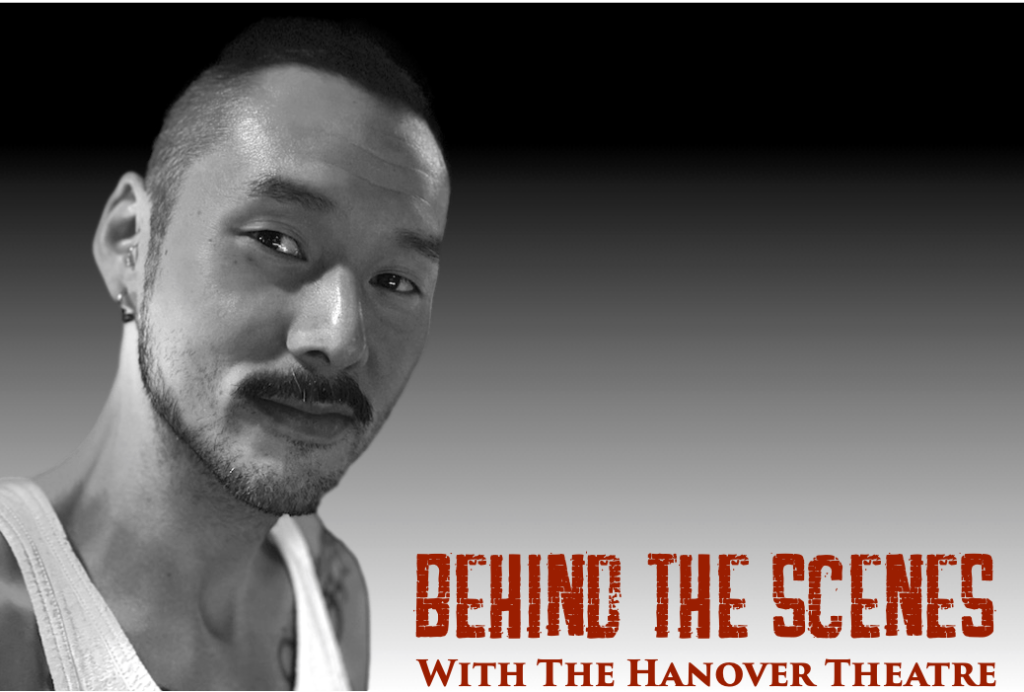Vice President of Communications for The Hanover Theatre and Conservatory Lisa Condit spoke with Julius Caesar creative team members Kate Moncrief and Lex Liang. Read on for highlights from the interview, or listen to the full interview below. Then tune in to Talk of the Commonwealth with Hank Stolz on WCRN 830AM Fridays at 9 AM and Saturdays at 1 PM for more behind-the-scenes interviews.
Lisa: I’m excited to bring you some more behind-the-scenes conversations with two members of our creative team for THT Rep’s Julius Caesar. I have Kate Moncrief, she’s the associate director and dramaturg for Julius Caesar and Lex Liang, who is in charge of costumes and scenic design.
Kate: I’m thrilled to be here and to be able to talk about this production of Julius Caesar. In my day job, I’m a professor at Worcester Polytechnic Institute (WPI) where I specialize in Shakespeare. In this production, I’m serving in the role of associate director with Livy Scanlon. I am also the dramaturg. That might be an unfamiliar word or role for people, so the dramaturg is the literary historical and cultural expert. It’s my job to provide historical context, to define words and to ask questions about the direction of the production, as well as answer questions. I’ll prepare background research and work individually with the actors, so they understand their roles. I help the cast and creative team understand both the world of Shakespeare’s Rome, what Shakespeare’s doing and then, what we are doing.
Lisa: What’s exciting is how that really plays into costume design because sometimes people are thinking what, besides the toga, are people going to be wearing? I know that really takes it down to the very base level, so Lex, you have some challenges and, I imagine, a lot of fun preparing for this. Tell us a little bit about yourself and how you came to be involved with our production of Julius Caesar.
Lex: I am the scenic and costume designer, and I’m based in New York. I can guarantee you that it will not look like a frat party. I’ve been designing for theatre professionally for almost 20 years now, and it’s really exciting to be approaching a piece like Julius Caesar. Livy wants to set in ancient Rome, but doing so on a large, almost operatic, scale because the Common is so extensive. In viewing our aesthetic with that of ancient Rome, but also seeing it through a contemporary lens or contemporary perspective. This is one of the things that I look forward to working with Kate on, digging through that text and gleaning all her brilliance, as well as incorporating that into ultimately the aesthetic of the costume and the properties design.
Connecting with Julius Caesar
Lisa: Both of you are such a great example of how the performing arts is all encompassing. Almost regardless of what your area of expertise is, or your interests are, it’s important for making theatre and literature come to life to have these skills and the ability to integrate them. I’m excited to hear how the history, and some of that context, has come into the conversations about the costumes and the production of Julius Caesar.
Kate: The setting for this production, the steps of City Hall into Worcester Common, is an inspiring location. It’s also a gift for the city of Worcester, tickets are going to be free and it’s going to run the whole month of August. One of the first things that a dramaturg usually asks is, “Why this play?” “Why now?” Why does the city of Worcester need a production of Julius Caesar? Shakespeare wrote this play in about 1599. He’s taking a story out of Roman history, and he is making some significant changes for theatricality and for storytelling. The events take place over several months and Shakespeare compresses those, which gives us heightened theatrical action. We’re looking at a play that is really asking some important questions about the world we live in, about politics, about choices that we make, about power. How do we think about that in Worcester? Every play should be for its own community. Setting this in downtown Worcester, in our own city, among people, is key for us. We have this beautiful and incredible civic site, so how do we tell Shakespeare’s story for us, now.
Lex: It really starts with the concept that Livy is bringing to the table and the rest of us are bringing to life here, and it started with racially conscious casting.
We have a cast that reflects the demographic, which I think is important, especially when it comes to Shakespearean pieces. The other thing that is affecting my job is the changing of historically gender specific roles.
I think it’s great, and I look forward to filling that concept visually. Speaking of togas, only (free) men wore togas. If a woman wore a toga, she might be mistaken for a prostitute. We can see this historical piece through a more contemporary lens but pay homage to ancient Rome and use those dressing rules and those historic specifics about the clothing and other aspects of dress. How do we interpret those to make sense within our world? It will be challenging, but I think it will be a lot of fun.
Lisa: We have these preconceptions of what it means to watch something that’s happening in this time, in Julius Caesar. I thought that the toga example was a really good one, are there some other key things regarding fabrics or headpieces that we should keep an eye on?
Lex: We’re pulling together the research and the various visual imagery. What I would urge folks to think about in this piece is, we have this tendency as audience members to sit at arm’s length when we watch a historical piece unfold in front of us. We’re watching it through almost this invisible barrier of, okay, we’re here in the 21st century and they’re there, back in BC times. We must realize that life, communities, relationships and all those interpersonal dynamics always remain the same. People got up, put on clothes and went to work. When you shrink that historical gap, that historical perception, I think you are then able to forget that you’re seeing costume so much and just accept that you’re seeing clothes.


